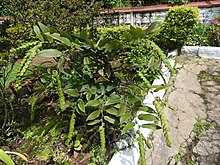Phyllodium pulchellum is an Asian plant in the family Fabaceae.
| Phyllodium pulchellum | |
|---|---|

| |
| Scientific classification | |
| Kingdom: | Plantae |
| Clade: | Tracheophytes |
| Clade: | Angiosperms |
| Clade: | Eudicots |
| Clade: | Rosids |
| Order: | Fabales |
| Family: | Fabaceae |
| Subfamily: | Faboideae |
| Clade: | Non-protein amino acid-accumulating clade |
| Clade: | Millettioids |
| Tribe: | Desmodieae |
| Genus: | Phyllodium |
| Species: | P. pulchellum
|
| Binomial name | |
| Phyllodium pulchellum | |
| Synonyms | |
| |
Distribution and habitat
editPhyllodium pulchellum is widely distributed in tropical Asia and also in the Ryukyu Islands, Taiwan and Australia's Northern Territory.[1]
Medicinal
editTraditional
editIn Bangladesh, a bark decoction is used for hemorrhage, diarrhea, poisoning and eye diseases. Flowers are used in biliousness.[2]
Chemical composition
editPlant: Bufotenin and its methyl ether, DMT and its oxides, two tryptamine derivatives, gramine, 15 indole-3-alkylamine, tryptophan bases, β-carbolines
Seeds: Galactomannan, L-glucosyl rhamnoside of physcion
Roots: Betulin, α-amyrin, β-sitosterol[2]
The alkaloids are mainly of three broad structural types, i.e. indole-3-alkylamine, beta-carbolines, and tetrahydro-β-carboline.[2]
References
edit- ^ a b "Phyllodium pulchellum". Germplasm Resources Information Network. Agricultural Research Service, United States Department of Agriculture. Retrieved 2008-04-30.
- ^ a b c Velmurugan, Gopal; S. P, Anand (2018-04-17). "Phyllodium pulchellum: A Potential medicinal plant - A review" – via ResearchGate.